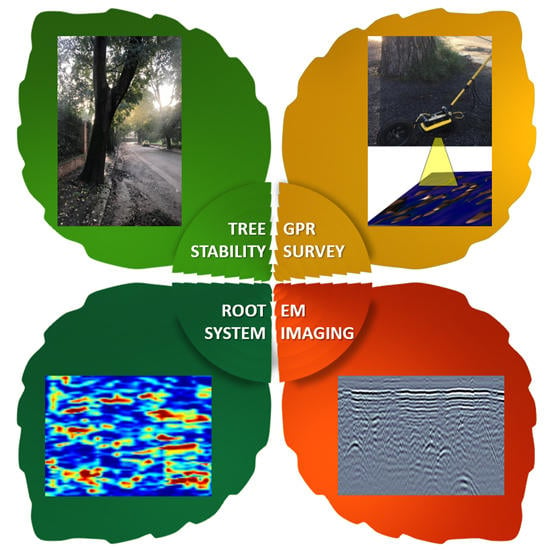A posteriori GPR Evaluation of Tree Stability: A Case Study in Rome (Italy)
Abstract
:1. Introduction
2. Materials and Methods
3. Results and Discussion
3.1. Area 1: via di Valle Delle Camene
3.2. Area 2: Piazza Beata Vergine Del Carmelo
3.3. Area 3: the AUR Garden
3.4. The SWOT Analysis
4. Conclusions
Author Contributions
Funding
Acknowledgments
Conflicts of Interest
References
- Singh, V.S.; Pandey, D.N.; Chaudhry, P. Urban Forests and Open Green Spaces: Lessons for Jaipur, Rajasthan, India; Paper No. 1/2010; RSPCB Occasional: Jaipur, Rajasthan, 2010. [Google Scholar]
- Trowbridge, P.; Bassuk, N.L. Trees in the Urban Landscape: Site Assessment, Design and Installation; Wiley and Sons, Inc.: Hoboken, NJ, USA, 2004. [Google Scholar]
- Costello, L.R.; Elmore, C.L.; Steinmaus, S. Tree root response to circling root barriers. J. Arboric. 1997, 23, 211–218. [Google Scholar]
- Gilman, E.F. Root barriers affect root distribution. J. Arboric. 1996, 22, 151–154. [Google Scholar]
- Wagar, J.A.; Barker, P.A. Tree root damage to sidewalks and curbs. J. Arboric. 1983, 9, 177–181. [Google Scholar]
- Wagar, J.A. Reducing surface rooting of trees with control planters and wells. J. Arboric. 1985, 11, 165–171. [Google Scholar]
- Barker, P.A.; Peper, P. Strategies to prevent damage to sidewalks by tree roots. J. Arboric. 1995, 19, 295–309. [Google Scholar] [CrossRef]
- Grabosky, J.; Bassuk, N. Testing of structural urban tree soil materials for use under pavement to increase street tree rooting volumes. J. Arboric. 1996, 21, 197–201. [Google Scholar]
- McPherson, E.G.; Muchnick, J. Effects of street tree shade on asphalt concrete pavement performance. J. Arboric. 2005, 31, 303–310. [Google Scholar]
- Appleton, B.; Horsley, J.; Harris, V.; Eaton, G.; Fox, L.; Orband, J.; Hoysa, C. Trees for Parking Lots and Paved Areas. In Virginia Cooperative Extension; Publication 430-028; Virginia Polytechnic Institute and State University: Blacksburg, VA, USA, 2009. [Google Scholar]
- D’Amato, N.E.; Sydnor, T.D.; Knee, M.; Hunt, R.; Bishop, B. Which comes first, the root or the crack? J. Arboric. 2002, 28, 277–289. [Google Scholar]
- McPherson, E.G. Expenditures associated with conflicts between street trees root growth and hardscape in California. J. Arboric. 2000, 26, 289–297. [Google Scholar]
- Costello, L.R.; Jones, K.S. Reducing Infrastructure Damage by Tree Roots: A Compendium of Strategies; International Society of Arboriculture: Cohasset, CA, USA, 2003. [Google Scholar]
- McPherson, E.G.; Peper, P. Infrastructure repair costs associated with street trees in 15 cities. In Proceedings of an International Workshop on Trees and Buildings; Watson, G.W., Neely, D., Eds.; International Society of Arboriculture: Champaign, IL, USA, 1995. [Google Scholar]
- Smiley, E.T.; Calfee, L.; Fraedrich, B.R.; Smiley, E.J. Comparison of structural and noncompacted soils for trees surrounded by pavement. Arboric. Urban For. 2006, 32, 164–169. [Google Scholar]
- Roberts, J.; Jacksn, N.; Smith, M. Tree Roots in the Built Environment; Centre for Ecology and Hydrology (CEH): Crown, UK, 2006. [Google Scholar]
- Ferrara, C.; Barone, P.M.; Pettinelli, E.; Salvati, L. Ground Penetrating Radar as a remote-sensing approach to investigate the root system architecture beneath the soil. Appl. Ecol. Environ. Res. 2014, 12, 695–702. [Google Scholar] [CrossRef]
- Ferrara, C.; Salvati, L.; Barone, P.M. Tree root system imaging using Ground Penetrating Radar. Ann. Silvic. Res. 2017, 41, 80–83. [Google Scholar] [CrossRef]
- Barone, P.M. Understanding Buried Anomalies: A Practical Guide to GPR; LAP Lambert Academic Publishers: Saarbrücken, Germany, 2016. [Google Scholar]
- Barone, P.M.; Ferrara, C.; Di Maggio, R.; Salvati, L. When the Crime Scene Is the Road: Forensic Geoscience Indicators Applied to Road Infrastructure and Urban Greening. Geosciences 2016, 6, 50. [Google Scholar] [CrossRef]
- Haala, N.; Brenner, C. Extraction of buildings and trees in urban environments. ISPRS J. Photogramm. Remote Sens. 1999, 54, 130–137. [Google Scholar] [CrossRef]
- Wu, Y.; Guo, L.; Cui, X.; Chen, J.; Cao, X.; Lin, H. Ground Penetrating Radar-based automatic reconstruction of three-dimensional coarse root system architecture. Plant Soil 2014, 383, 155–172. [Google Scholar] [CrossRef]
- Butnor, J.R.; Stover, D.B.; Roth, B.E.; Johnsen, K.H.; Day, F.P.; McInnis, D. Using Ground-Penetrating Radar to Estimate Tree Root Mass: Comparing Results from Two Florida Surveys. In Handbook of Agricultural Geophysics; Allred, B.J., Daniels, J.J., Ehsani, M.R., Eds.; CRC Press: Taylor & Francis Group: Boca Raton, FL, USA, 2008. [Google Scholar]
- Ferrara, C.; Barone, P.M.; Steelman, C.; Pettinelli, E.; Endres, A.L. Monitoring shallow soil water content under natural field conditions using the early-time GPR signal technique. Vadose Zone J. 2013, 12. [Google Scholar] [CrossRef]
- Stover, D.; Day, F.P.; Butnor, J.R.; Drake, B.G. Effect of elevated CO2 on coarse-root biomass in Florida scrub detected by ground-penetrating radar. Ecology 2007, 88, 1328–1334. [Google Scholar] [CrossRef]
- Hruška, J.; Cermák, J.; Sustek, S. Mapping tree root system with ground-penetrating radar. Tree Physiol. 1999, 19, 125–130. [Google Scholar] [CrossRef] [PubMed]
- Cermák, J.; Hruška, J.; Martinková, M.; Prax, A. Urban tree root systems and their survival near houses analyzed using ground penetrating radar and sap flow techniques. Plant Soil 2000, 219, 103–116. [Google Scholar] [CrossRef]
- Annan, A.P. Ground Penetrating Radar: Principles, Procedures & Applications; Technical paper; Sensors & Software, Inc.: Mississauga, ON, Canada, 2004. [Google Scholar]
- Jol, H.M. Ground Penetrating Radar: Theory and Applications; Elsevier Science: Amsterdam, The Netherlands; Oxford, UK, 2009. [Google Scholar]
- Persico, R. Introduction to Ground Penetrating Radar: Inverse Scattering and Data Processing; Wiley-IEEE Press: Hoboken, NJ, USA, 2014; ISBN 978-1118305003. [Google Scholar]
- Pettinelli, E.; Barone, P.M.; Mattei, E.; Lauro, S.E. Radio wave techniques for non-destructive archaeological investigations. Contemp. Phys. 2009, 52, 121–130. [Google Scholar] [CrossRef]
- Malinovski, R.A.; Nutto, L.; Wiese, W.S.; Brunsmeier, M. Non-destructive analysis of the root system and tree growth parameters. Revista Árvore 2016, 40, 289–295. [Google Scholar] [CrossRef]
- Li, W.; Wen, J.; Xiao, Z.; Xu, S. Application of Ground-Penetrating Radar for Detecting Internal Anomalies in Tree Trunks with Irregular Contours. Sensors 2018, 18, 649. [Google Scholar] [CrossRef]
- Xiao, X.; Wen, J.; Xiao, Z.; Li, W. Detecting and Measuring Internal Anomalies in Tree Trunks Using Radar Data for Layer Identification. J. Sens. 2018, 2, 1–11. [Google Scholar] [CrossRef]
- Ježová, J.; Mertens, L.; Lambot, S. Ground-penetrating radar for observing tree trunks and other cylindrical objects. Constr. Build. Mater. 2016, 123, 214–225. [Google Scholar] [CrossRef]
- Takahashi, K.; Aoike, K. Estimation of average electromagnetic wave velocity in tree trunks for the reflection imaging by GPR. In Proceedings of the EAGE-HAGI 1st Asia Pacific Meeting on Near Surface Geoscience and Engineering, Yogyakarta, Indonesia, 9–13 April 2018. [Google Scholar] [CrossRef]
- Leigh, D. SWOT Analysis. In Handbook of Improving Performance in the Workplace; Silber, K.H., Foshay, W.R., Watkins, R., Leigh, D., Moseley, J.L., Dessinger, J.C., Eds.; Wiley and Sons, Inc.: Hoboken, NJ, USA, 2009. [Google Scholar]
- Zheng, Y.; Jiang, F. SWOT Analysis of Urban Greening Maintenance and Management in the Central Pearl River Delta. USA-China Sci. Cult. Media Corp. 2013, 5, 1–3. [Google Scholar]
- Roma Capitale, Bilancio Arboreo, Dipartimento Tutela Ambientale. Available online: https://www.comune.roma.it/web/it/scheda-servizi.page?contentId=INF70550&stem=verde_urbano (accessed on 25 May 2019).

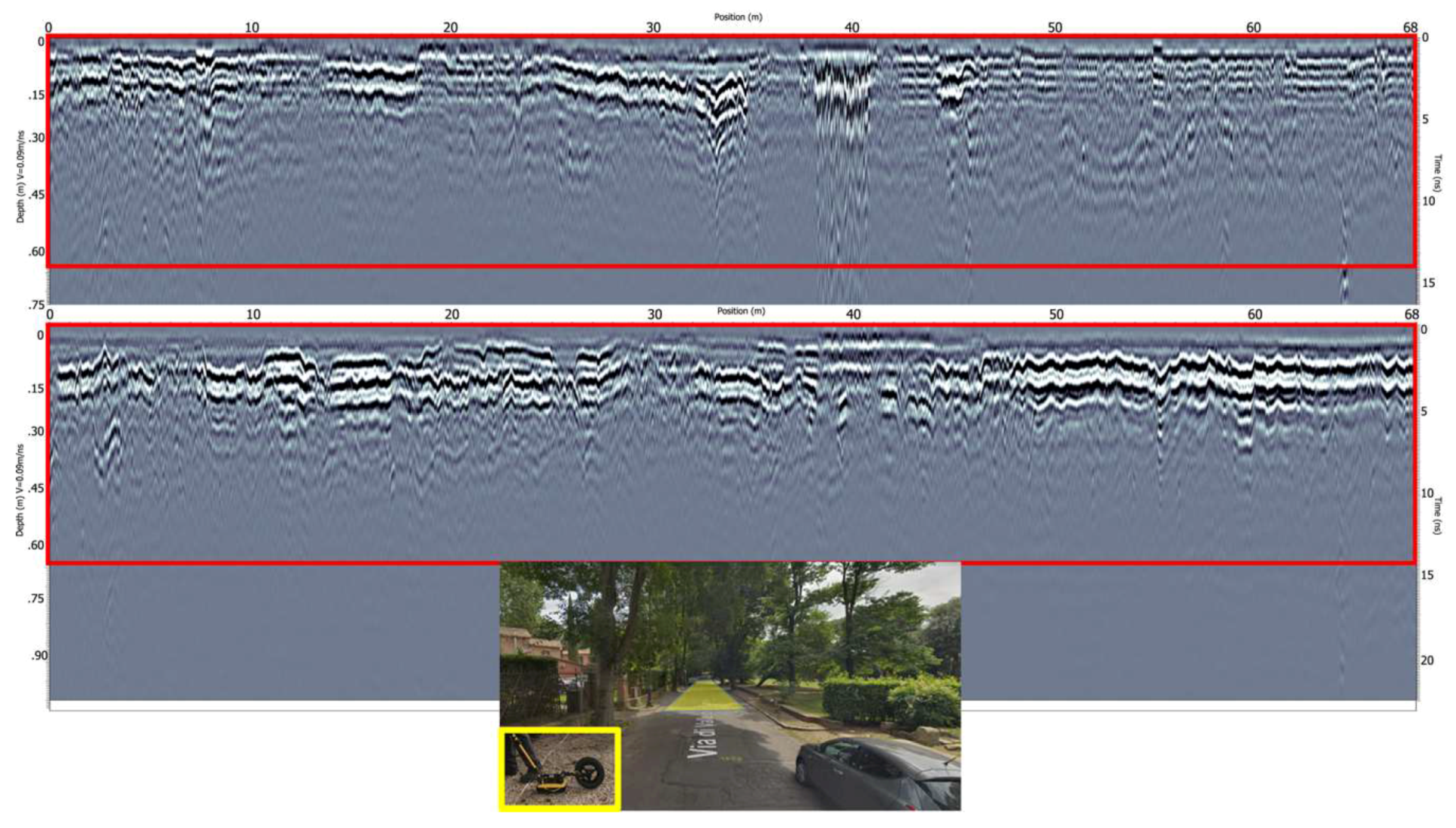






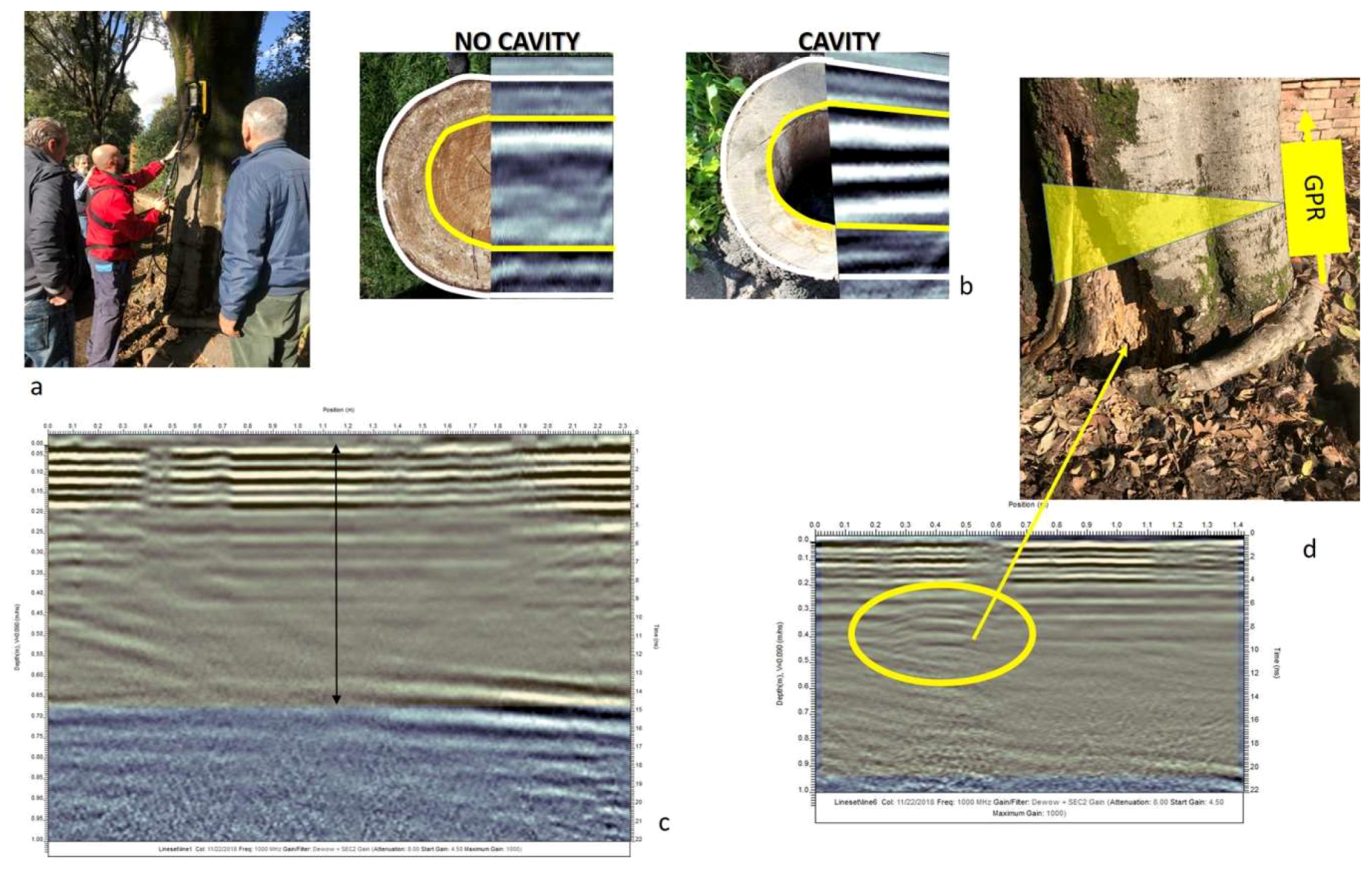
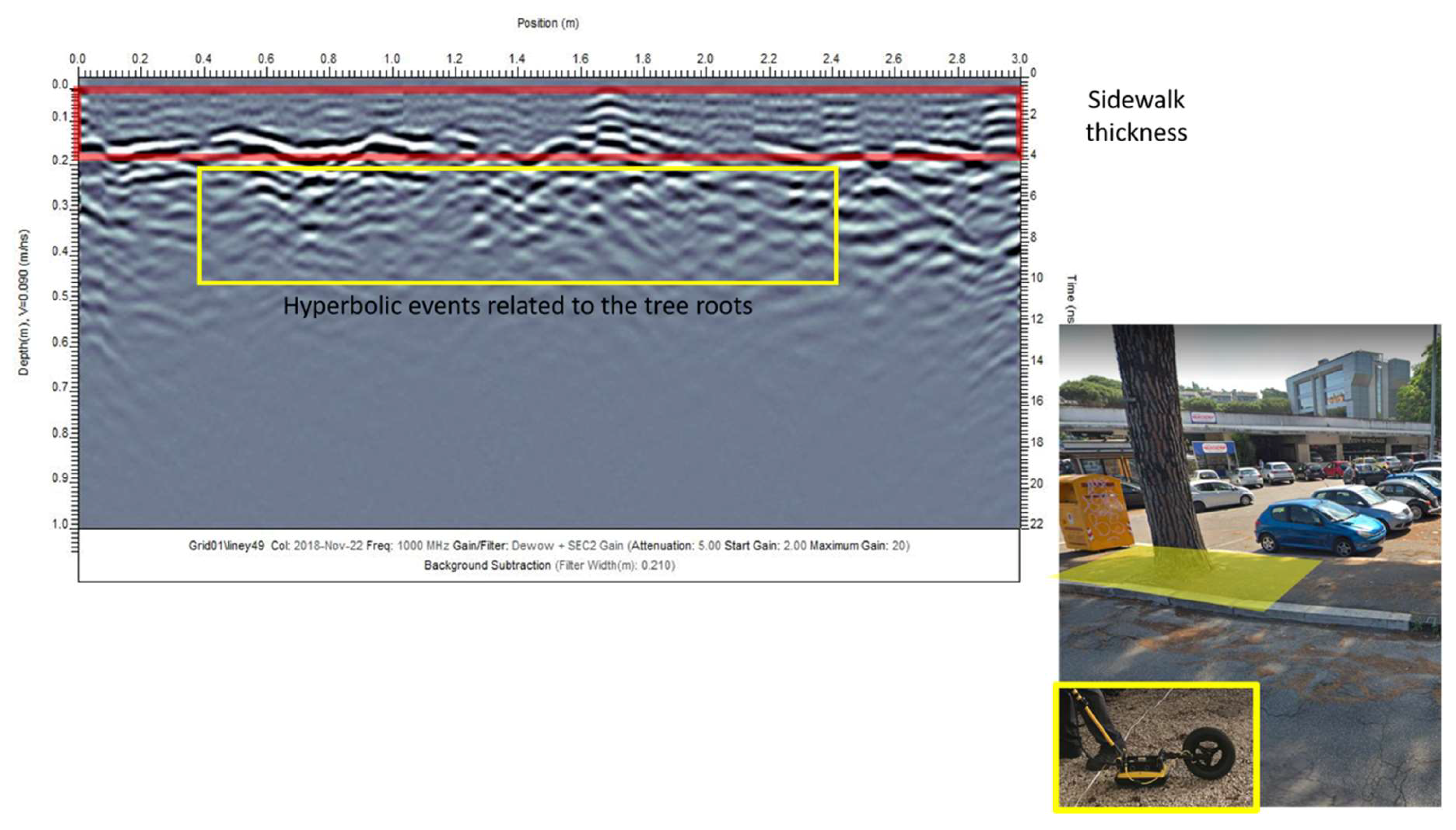
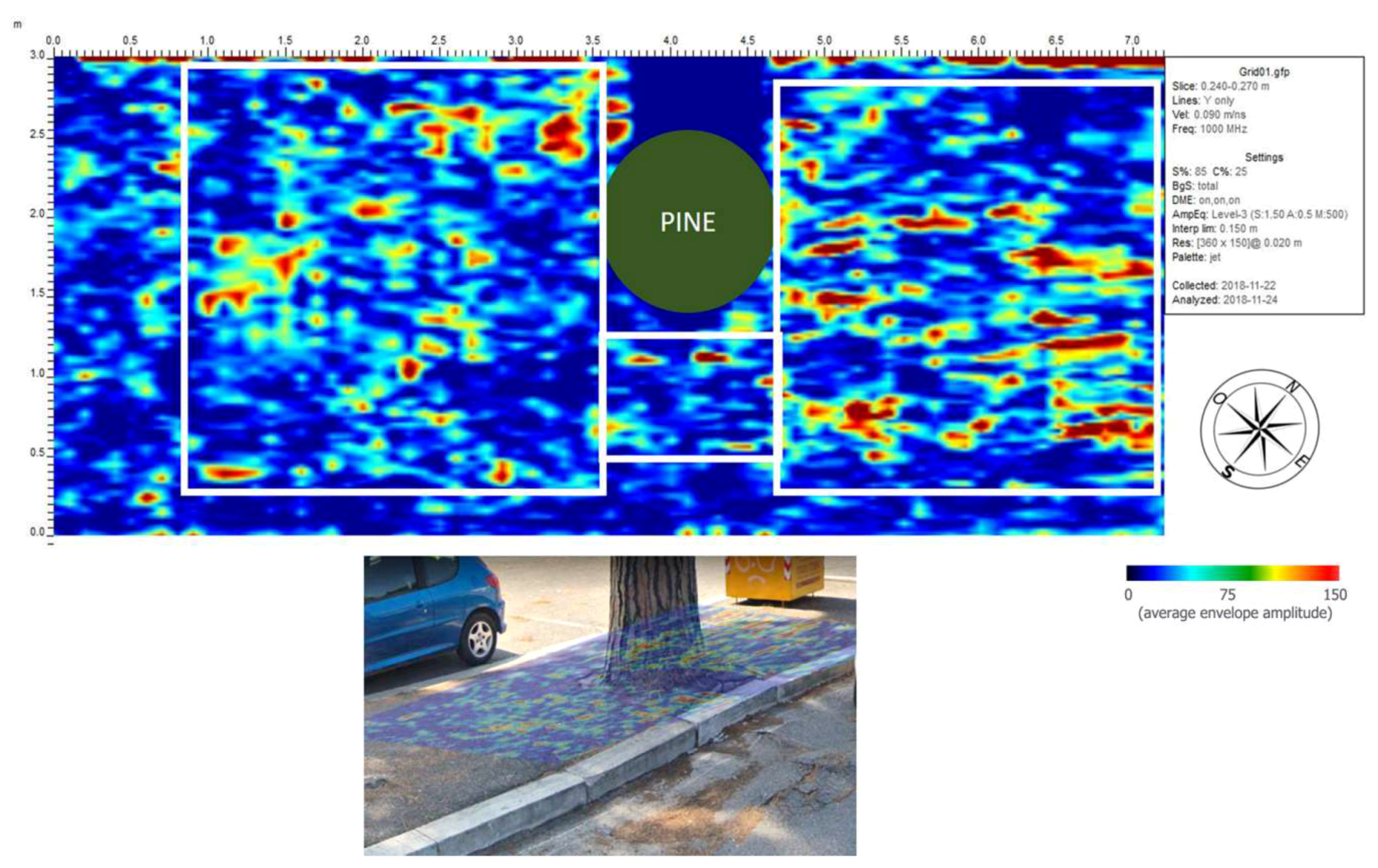

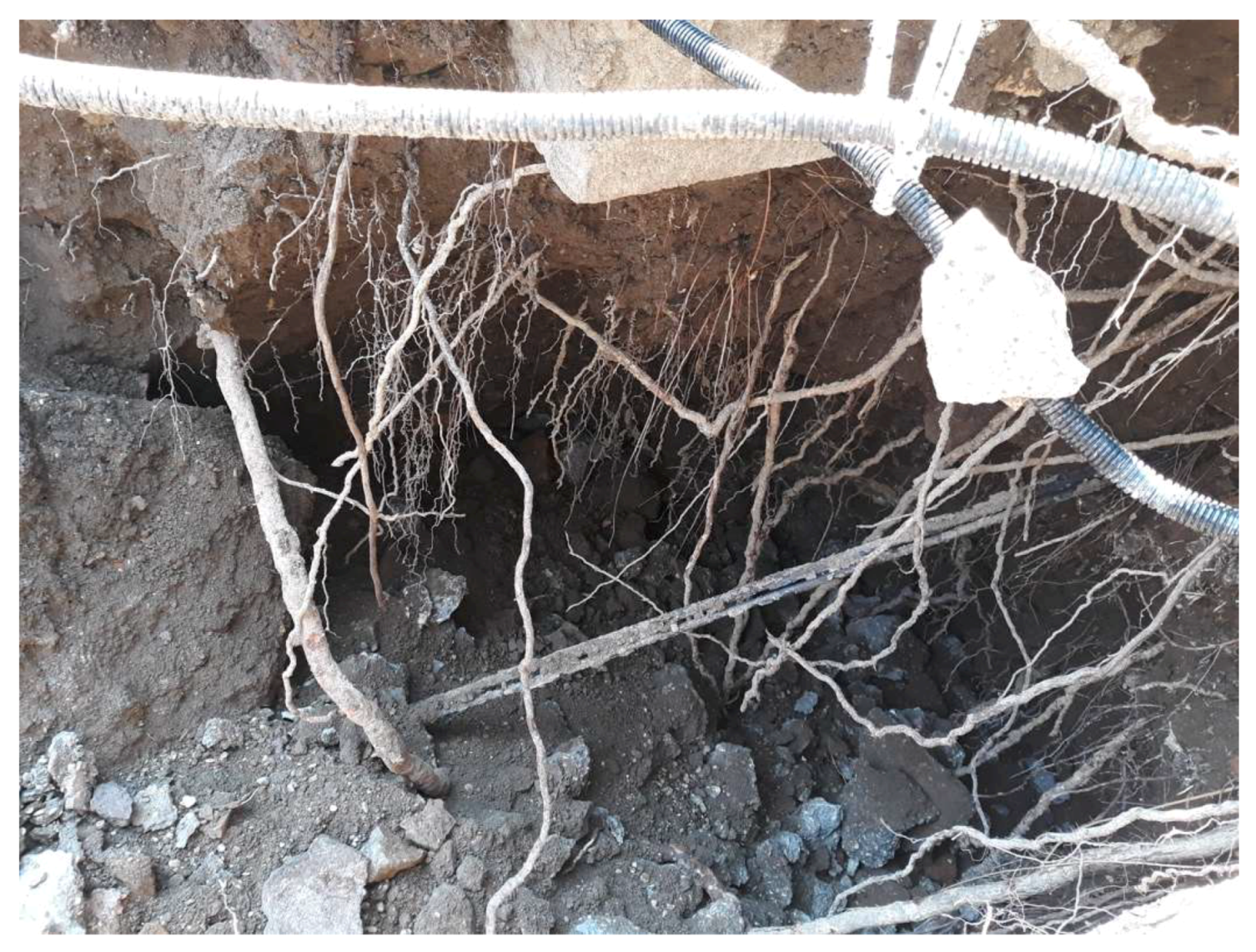






© 2019 by the authors. Licensee MDPI, Basel, Switzerland. This article is an open access article distributed under the terms and conditions of the Creative Commons Attribution (CC BY) license (http://creativecommons.org/licenses/by/4.0/).
Share and Cite
Barone, P.M.; Ferrara, C. A posteriori GPR Evaluation of Tree Stability: A Case Study in Rome (Italy). Remote Sens. 2019, 11, 1301. https://doi.org/10.3390/rs11111301
Barone PM, Ferrara C. A posteriori GPR Evaluation of Tree Stability: A Case Study in Rome (Italy). Remote Sensing. 2019; 11(11):1301. https://doi.org/10.3390/rs11111301
Chicago/Turabian StyleBarone, Pier Matteo, and Carlotta Ferrara. 2019. "A posteriori GPR Evaluation of Tree Stability: A Case Study in Rome (Italy)" Remote Sensing 11, no. 11: 1301. https://doi.org/10.3390/rs11111301
APA StyleBarone, P. M., & Ferrara, C. (2019). A posteriori GPR Evaluation of Tree Stability: A Case Study in Rome (Italy). Remote Sensing, 11(11), 1301. https://doi.org/10.3390/rs11111301





